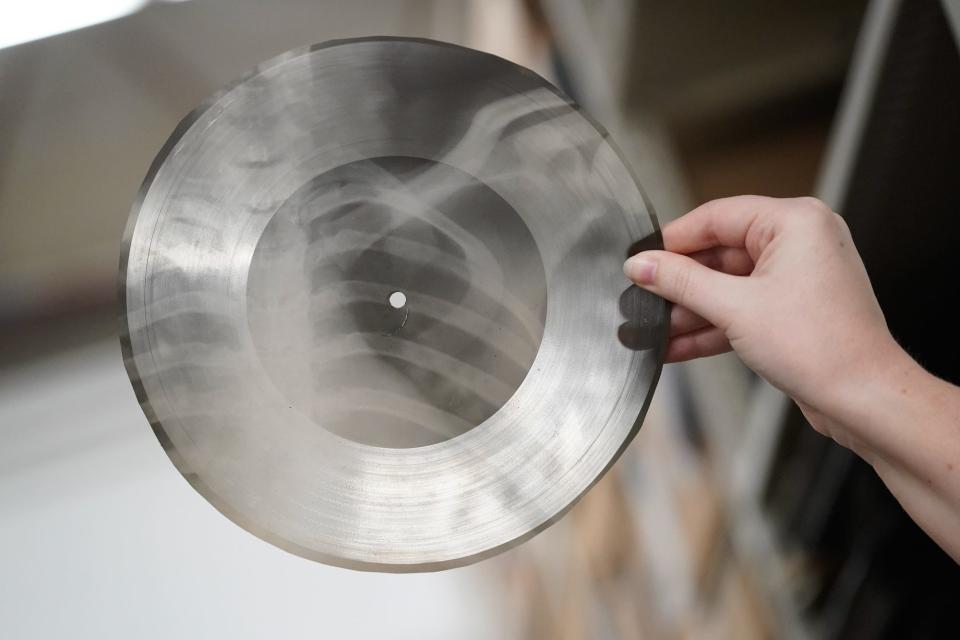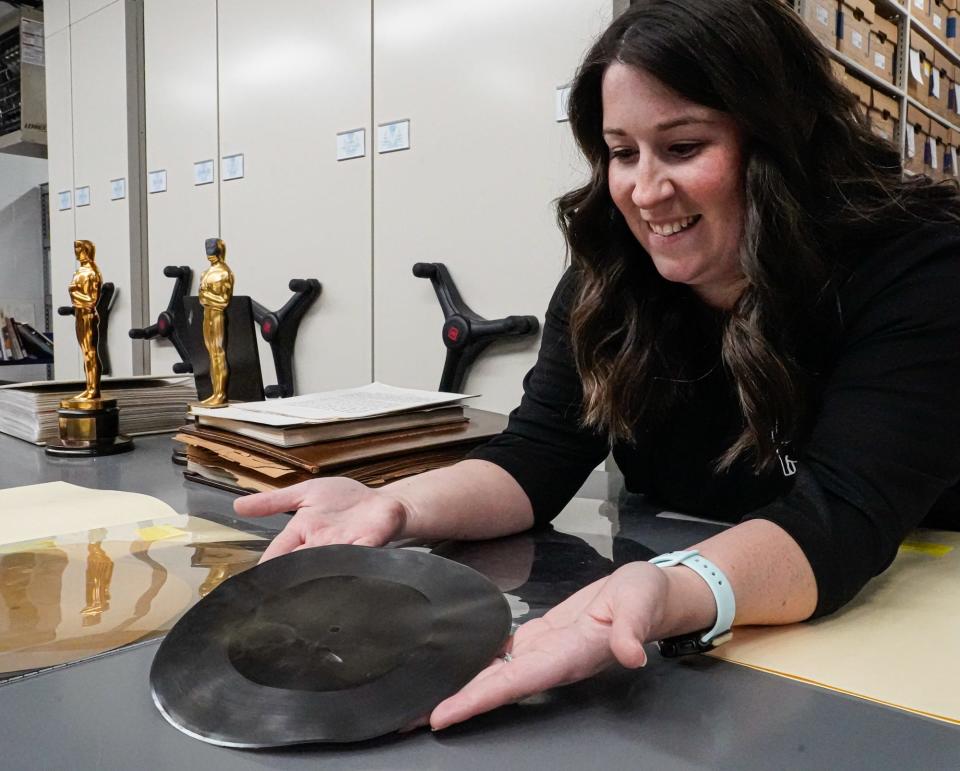Unique history of Soviet-era 'bone records' shared in new Carmel displays
A well-connected dealer in the Cold War Soviet Union could get an enterprising music fan some of the good stuff — American jazz, pop and early rock 'n' roll — for the right price.
At a time when popular Western music was strictly outlawed, "bone records" — bootlegged recordings of illegal music scratched into X-ray film — could be folded and stuffed into jackets, bought and sold on the streets like any other contraband. The recordings might not sound great or last very long, but they offered Soviet youth a taste of forbidden audio fruit.
In 2013, the Carmel-based Great American Songbook Foundation acquired a rare collection of these Soviet-era bone records. Now, some of those recordings are being displayed for the first time as part of two new exhibits.
"In all of the years we've had (the bone records), I haven't met anybody who's heard of them or knows the story," Songbook Foundation executive director Chris Lewis told IndyStar during an April tour of the Foundation's archives. "It's going to be a way to tell the stories and highlight our work in a very unique way."
Bone records: 'A story in which music matters'

Bone records are often referred to as "rib records" or "ribs," as much of the film originated as chest X-rays taken during a tuberculosis surge in Eastern Europe during the '40s and '50s.
Recording lathes captured forbidden radio tracks — often broadcast into the Soviet Union by the British and American governments. Only one side could be used in this way, with enough space for one song. A cigarette burned the center hole needed to fit on a turntable.
Stephen Coates, a British composer, writer and music producer, has written two books on X-ray recordings. He met with the Songbook Foundation to assist in the latter's research.
Coates first came across a bone record while performing in Russia in 2013. Unlike his bandmates, Coates is not a drinker, and he habitually plumbs flea markets and shops in the early morning hangover hours while on tour.
Bone records were made from 1946 until 1964, when the availability of reel-to-reel tape recorders rendered the difficult lathe recorders obsolete, Coates said. Bootleggers could bribe medical workers for unused film, which produced a better recording quality.
Indy concerts: Aerosmith announces farewell tour stop in Indianapolis
In addition to radio broadcasts, bone recordings captured live performances in the Soviet Union.
Coates regularly leads academic discussions about bone records. He's also curated his own traveling exhibit on bone recordings, which he has displayed throughout the world.
"Ordinary people love this story because it's a story in which music matters," Coates told IndyStar in an interview. "I think everybody can relate to that. This is also a story about human endeavor in the face of tyranny, and I think people can relate to that, too."
Bone record history is particularly poignant at the moment, Coates said, as Russian censorship has again clamped down during Russia's war with Ukraine.
The outlawed medium represents a chapter in American history many have not heard.
"America is so important in this story," Coates said. "For a lot of young kids in the Soviet Union, American films, American music and American clothes were a big source of inspiration for them."
The bone record collection
A small part of that story has been kept carefully in the Foundation's archives for a decade.
Bone records deteriorate rapidly. Emily Rapoza, the Foundation's library and archive director, guessed each record could hold together for maybe 10 plays.
Both exhibits will rotate out one or two bone records from the Foundation's 18-recording collection, but visitors will be able to hear digitized audio collected from several of the recordings.
The collection includes Louis Armstrong's version of "When the Saints Go Marching In," recorded onto a pristine skull X-ray.
A recording of Bill Haley and His Comets' "(We're Gonna) Rock Around the Clock," widely considered rock 'n' roll's first hit, is dyed orange. Its sound quality was relatively good, with only a faint hiss.
Another Foundation bone record, "We Just Couldn't Say Goodbye" by the Andrews Sisters, was a far more sinister listen, with slowed and distorted voices droning on.
When the Foundation first posted information on its bone record collection online, the general feedback included diagnoses from doctors reading the X-rays, Rapoza said.
The collection also includes x-ray recordings of banned Russian and Eastern European music, from local folk songs to Russian-language versions of Western hits. Indianapolis resident Richard Judy, who purchased them in the 1950s while studying in the Soviet Union as an exchange student, donated his collection to the Foundation in 2013.
"The exhibits are going to be a wonderful way to tell this story," Lewis said.
More coverage: An Aretha tribute, masterworks and more: Carmel Symphony's 2022-23 season at the Palladium
Exhibits only the beginning
Several of the black market records are now on display in the south lobby of The Palladium, as well as in the Carmel office of Forté Sports Medicine and Orthopedics at 10767 Illinois St.
Forté, previously known as Methodist Sports Medicine, is sponsoring the collection's preservation and spearheading plans alongside the Foundation to get the Cold War pop culture relics in front of more people.
CEO Marty Rosenberg first learned of the bone records during a tour of the Songbook Foundation's collection. He sees the bone record sponsorship as a natural marketing partnership and a way to diversify Forté's community support beyond athletics.
The sponsorship wasn't a set financial donation, Rosenberg said. Forté built its own display for the exhibit and hopes to create a traveling version for orthopedic trade shows, as well as partner with the Foundation on future displays.
"It’s rare you get opportunity to advertise, educate and entertain all wrapped into one," Rosenberg said.

The bone records are not the only treasures stashed away in back rooms at the Palladium.
In addition to the bone records, the archives house costumes worn by Ella Fitzgerald, a traveling trunk owned by Bing Crosby, two Academy Award statuettes, thousands of unreleased pages of sheet music and letters from famed composers and several pianos, including one owned by "Wizard of Oz" composer Harold Arlen and another signed by every first lady of the United States since Betty Ford.
Lewis said the Foundation, which is an affiliate of The Grammy Museum based in Los Angeles, is working on design concepts and has identified two possible locations in Carmel and Indianapolis for a museum to house the archives' most treasured pieces from its collection of around 500,000 items.
Lewis's hope is for future bone record exhibits to include an interactive component, such as allowing visitors to create their own X-ray recordings.
Visitors to Forté's office may view its bone record display during regular business hours, typically 8 a.m. until 4:30 p.m., while The Palladium's will be open during performances at the venue. Both exhibits will be on display for the foreseeable future.
Looking for things to do? Our newsletter has the best concerts, art, shows and more — and the stories behind them
Rory Appleton is the pop culture reporter and columnist at IndyStar. Contact him at 317-552-9044 and rappleton@indystar.com, or follow him on Twitter at @RoryDoesPhonics.
This article originally appeared on Indianapolis Star: Unique history of Soviet-era 'bone records' shared in Carmel displays

